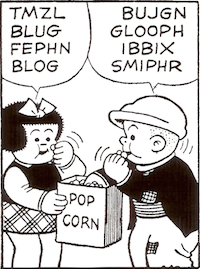Stanley Fish. How to Write a Sentence: And How to Read One. New York. HarperCollins. 2011. $19.99.
In the summer of 1979, I taught a remedial writing course for incoming college freshmen. The idea was to get students up to speed in six weeks with the use of a workbook in sentence construction. I was a grad student teaching for the first time; the course design was not of my making. Page by page, we trudged through the workbook, and the students filled in blanks to create sentences of ever-increasing complexity. The students became virtuosi of sentence form, with words, phrases, and clauses falling into place. A typical piece of work went something like this: write a sentence with an introductory dependent clause, a compound subject, a non-restrictive clause, a transitive verb in the active voice, an indirect object, a direct object, and a prepositional phrase. Then came the final work of the course — writing an essay. Without blanks to fill in, the students fell back upon past habits of writing, and the results were disastrous. I remember reading the essays and wondering why my elders thought that constructing single sentences in a void was good preparation for writing.
And now I’m wondering why Stanley Fish thinks that constructing single sentences in a void is good preparation for writing. How to Write a Sentence though is hardly as programmatic as my 1979 workbook: Fish conceives of a sentence not as an arrangement of grammatical units but as a matter of “structures of logic and rhetoric within which and by means of which meanings — lots of them — can be generated.” A standard strategy in this book: present a sentence that does a certain sort of thing; imitate it; invite the reader to do the same. Here for instance is a sentence from Henry James, one that “filters [an] event through layers of reflection”:
When the porter’s wife (she used to answer the house-bell) announced “A gentleman — with a lady, sir,” I had, as I often had in those days, for the wish was father to the thought, an immediate vision of sitters.And Fish’s imitation:
As he reached the crest of the hill and saw the house with its imposing spires — they looked like spears ready to impale him — the door, moving it seemed under its own power, opened.“Not James by any means, but a passable cheap imitation,” Fish says. No, not James. But also just not a good sentence, with a strained and awkwardly sounded simile (spires, spears), a puzzling shift in perspective (as he looks at the spires, he sees the door?), and a perfunctory close. No strange “vision of sitters” here, just a door standing open, like a door. Fish apologizes for his imitations again and again: one “at least gestures in the direction” of Ford Madox Ford; another is “not as snappy and whiplike” as J.L. Austin, “but in the ballpark.” An imitation of Martin Luther King Jr. is “bathetic, even pathetic”; imitations of Jonathan Swift are “so lame.”
A reader might wonder: if this is the best Stanley Fish can do, what hope is there for me? Well, you just have to practice: “if you learn how to master the form, you can employ it ‘naturally’ when you have something important to say.” Become familiar with your tools, and “when an occasion of use turns up, you will be ready.” Keep at it, “and when it comes time to do it for real — to put this style in the service of a point you passionately want to make or an idea you want to champion — you will be ready.” No more ready, I suspect, than my students in the summer of 1979: it defies plausibility that imitating a handful of sentences (and taking up another Fish exercise — expanding three-word sentences into larger wholes) will make for good writing.
“You will be ready”: I’ve yet to figure out the you of How to Read a Sentence. At times, I suspect that the aspiring maker of passionate points and champion of ideas is an upscale middle-aged person. Who else is meant to enjoy Fish’s joking suggestion to use the word parataxis at a cocktail party? Yet HarperCollins is pitching this book as useful for college writing courses. (I have the e-mail to prove it.) And Adam Haslett’s cover blurb presents the book as a worthy successor to an earlier classroom text: “Both deeper and more democratic than The Elements of Style.” I’d welcome such a book, but How to Write a Sentence is nothing of the sort. Its most valuable pages are those where the emphasis on imitation drops out and Fish focuses on reading, performing the close analyses of sentences that one finds in his work on seventeenth-century prose. For sentence-writing inspiration, Virginia Tufte’s Artful Sentences: Syntax as Style (Graphics Press, 2006) is a far better choice. It’s a clear influence on How to Write a Sentence: both books begin by taking up the same Anthony Burgess sentence, and Fish quotes from Tufte’s comments on it. The difference is that Tufte presents more than a thousand sentences, patiently, methodically, and not for purposes of direct imitation but to show the reader many, many kinds of things that sentences can do. That’s what I call inspiration.
Related posts
Battling The Elements
Fish on Strunk and White
[There are some surprising mistakes in How to Write a Sentence: phrases identified as clauses (“a man in possession of a good fortune,” “in want of a wife”), parataxis badly explained, four lines from William Carlos Williams’s “The Red Wheelbarrow” turned into two, and a comma splice (page 73). Does no one check these things?]



comments: 0
Post a Comment